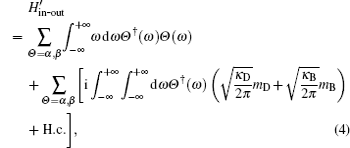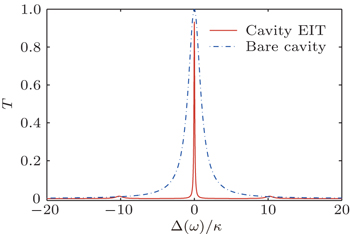† Corresponding author. E-mail:
‡ Corresponding author. E-mail:
§ Corresponding author. E-mail:
Project supported by the National Natural Science Foundation of China (Grants Nos. 11204080, 11274112, 91321101, and 61275215) and the Fundamental Research Fund for the Central Universities of China (Grants No. WM1313003).
We present a quantum-theoretical treatment of cavity linewidth narrowing with intracavity electromagnetically induced transparency (EIT). By means of intracavity EIT, the photons in the cavity are in the form of cavity polaritons: bright-state polariton and dark-state polariton. Strong coupling of the bright-state polariton to the excited state induces an effect known as vacuum Rabi splitting, whereas the dark-state polariton decoupled from the excited state induces a narrow cavity transmission window. Our analysis would provide a quantum theory of linewidth narrowing with a quantum field pulse.
Electromagnetically induced transparency (EIT) is a coherent interference effect where the absorption and dispersion of a resonant medium are strongly modified by a coupling field acting on the linked transition. [ 1 – 4 ] The EIT medium in an optical cavity known as intracavity EIT was first discussed by Lukin et al. [ 5 ] They have shown that the cavity response is drastically modified by intracavity EIT, resulting in frequency pulling and a substantial narrowing of spectral features. By following this seminal work, significant experimental advance has been made in narrowing the cavity linewidth [ 6 – 9 ] and enhancing the cavity lifetime. [ 10 ]
The previous semi-classical treatments of cavity linewidth narrowing and lifetime enhancing with intracavity EIT were based on the solution of the susceptibility of EIT system. Here we present a quantum-theoretical treatment of cavity linewidth narrowing with intracavity EIT. By means of intracavity EIT, the photons in the cavity are in the form of cavity polaritons: bright-state polariton and dark-state polariton. Strong coupling of the bright-state polariton to the excited state induces an effect known as vacuum Rabi splitting, whereas the dark-state polariton decoupled from the excited state induces a narrow cavity transmission window v = cos 2 θ v 0 , with v 0 being the empty-cavity linewidth and θ the mixing angle of the dark-state polariton. [ 11 ] When the atom-cavity system is in the collective strong coupling regime, a weak control field is sufficient for avoiding the absorption owing to spontaneous emission of the excited state, and then the dark-state polariton induces a very narrow cavity linewidth.
Now we try to solve the quantum dynamics of EIT in an optical standing-wave cavity with input–output processes (Fig. 








(a) Schematic setup to cavity linewidth narrowing with dark-state polaritons. (b) Relevant atomic level structure and transitions.

The external fields interact with cavity mode a through two input ports α in , β in , and two output ports α out , β out . The Hamiltonian for the cavity input–output processes is described by [ 14 ]


In the intracavity EIT system, only the bright-state polariton m B resonantly couples to the excited state, leading to the splitting of the cavity transmission peak for the bright-state polariton m B into a pair of resolvable peaks at 

According to quantum Langevin equation, the evolution equation of the cavity dark-state polariton m D is given by [ 14 ]







 | Fig. 2. Transmission spectrum T as a function of Δ ( ω )/ κ for Ω = {5 g ,0.5 g } on the assumption that N = 400 and g = κ = γ e . |
To obtain the expression of cavity linewidth v in Eq. ( 







 | Fig. 3. Transmission spectrum as a function of Δ ( ω )/ κ , with cavity EIT and bare cavity, assuming the relevant parameters ( g , κ , γ e )/2 π ≈ (16,3.8,2.6) MHz, [ 19 ]   |
Now we briefly discuss the results of our theoretical treatment of intracavity EIT. If 




In summary, we have performed a theoretical investigation of intracavity EIT quantum mechanically. In intracavity EIT system, the cavity photons are in the form of cavity polaritons: bright-state polariton and dark-state polariton. Strong coupling of the bright-state polariton to the excited state leads to an effect known as vacuum Rabi splitting, whereas the dark-state polariton decoupled from the excited state induces a narrow transmission window. If the atom–cavity system is in the weak coupling regime, a strong control field is required for avoiding the absorption owing to spontaneous emission of the excited state. However, if atom-cavity system is in the collective strong coupling regime, a weak control field is sufficient for avoiding the absorption, and then the dark-state polariton induces a very narrow cavity linewidth. Our quantumtheoretical treatment of intracavity EIT would provide an alternative theory of linewidth narrowing with quantum field pulses.
| 1 | |
| 2 | |
| 3 | |
| 4 | |
| 5 | |
| 6 | |
| 7 | |
| 8 | |
| 9 | |
| 10 | |
| 11 | |
| 12 | |
| 13 | |
| 14 | |
| 15 | |
| 16 | |
| 17 | |
| 18 | |
| 19 | |
| 20 | |
| 21 |


